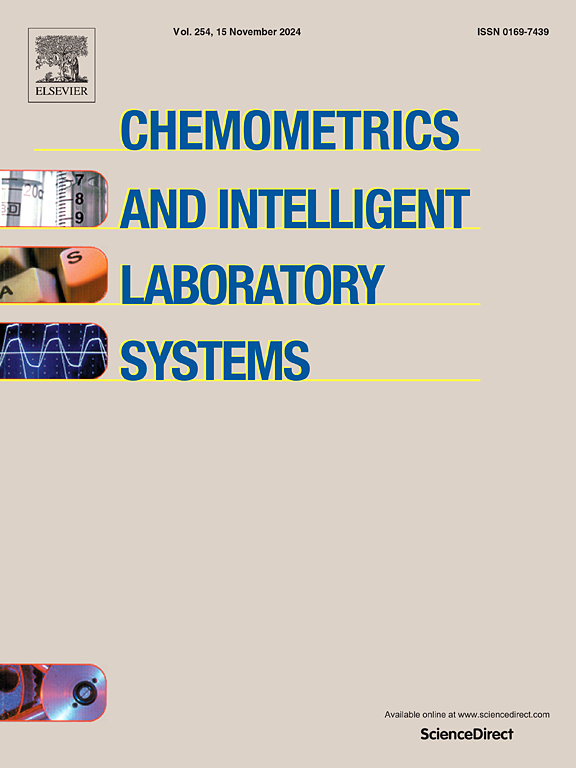Lightweight drought recognition model based on feature extraction of soybean multispectral images
IF 3.8
2区 化学
Q2 AUTOMATION & CONTROL SYSTEMS
Chemometrics and Intelligent Laboratory Systems
Pub Date : 2025-07-17
DOI:10.1016/j.chemolab.2025.105488
引用次数: 0
Abstract
Drought is an important stress factor restricting soybean's high yield and high quality. Rapid detection of soybean drought conditions is of great significance for scientific cultivation management and drought-resistant variety breeding. In view of the complex and diverse phenotypes of soybean canopy, the existing recognition algorithms have high feature dimensions and large amount of calculation, which are difficult to meet the requirements of lightweight models for portable devices to identify soybean drought. Thus, a lightweight soybean drought recognition model based on feature extraction and one-dimensional convolutional neural network is proposed in this paper. Firstly, the multispectral image of soybean canopy was taken as the research object, and ReliefF feature selection method was applied to extract 14 feature vectors from the original 37 phenotypic indicators calculated from soybean canopy image, and the correlation coefficient R2 reached 0.886. Finally, based on the selected dataset of soybean canopy phenotypic features, a seven-layer one-dimensional convolutional neural network was constructed to achieve a lightweight recognition model for soybean canopy drought (ReliefF_Conv), with an accuracy of 95.67 % and a inference time of only 0.000009 s. Compared with Back Propagation(BP), Radial Basis Function Network(RBF), Random Forest(RF), Support Vector Machine(SVM), Long Short-Term Memory(LSTM) and MobileNet models, the accuracy of the proposed model is increased by 14.42 %, 8.17 %, 5.05 %, 1.92 %, 14.42 % and 14.42 %, respectively. Compared with the full-variable model (OD_Conv), the accuracy of the proposed model is increased by 9.16 %, the training parameters were reduced by 64.2 %, and the inference efficiency has also increased by 70 %. The results achieved rapid detection of drought traits of soybean, and could provide basis and reference for water-saving irrigation and precise decision-making in drought-resistant varieties breeding, environmental regulation and scientific management.
基于大豆多光谱图像特征提取的轻量级干旱识别模型
干旱是制约大豆高产优质的重要胁迫因素。大豆干旱状况的快速检测对科学栽培管理和抗旱品种选育具有重要意义。鉴于大豆冠层表型复杂多样,现有识别算法特征维数高,计算量大,难以满足便携式设备对大豆干旱识别模型轻量化的要求。为此,本文提出了一种基于特征提取和一维卷积神经网络的轻型大豆干旱识别模型。首先,以大豆冠层多光谱图像为研究对象,采用ReliefF特征选择方法,从大豆冠层图像计算的原始37个表型指标中提取14个特征向量,相关系数R2达到0.886。最后,在选取的大豆冠层表型特征数据集的基础上,构建了一个七层一维卷积神经网络,实现了大豆冠层干旱的轻量化识别模型(ReliefF_Conv),准确率为95.67%,推理时间仅为0.000009 s。与反向传播(BP)、径向基函数网络(RBF)、随机森林(RF)、支持向量机(SVM)、长短期记忆(LSTM)和MobileNet模型相比,该模型的准确率分别提高了14.42%、8.17%、5.05%、1.92%、14.42%和14.42%。与全变量模型(OD_Conv)相比,该模型的准确率提高了9.16%,训练参数减少了64.2%,推理效率提高了70%。结果实现了大豆干旱性状的快速检测,可为节水灌溉和抗旱品种选育、环境调控和科学管理的精准决策提供依据和参考。
本文章由计算机程序翻译,如有差异,请以英文原文为准。
求助全文
约1分钟内获得全文
求助全文
来源期刊
CiteScore
7.50
自引率
7.70%
发文量
169
审稿时长
3.4 months
期刊介绍:
Chemometrics and Intelligent Laboratory Systems publishes original research papers, short communications, reviews, tutorials and Original Software Publications reporting on development of novel statistical, mathematical, or computer techniques in Chemistry and related disciplines.
Chemometrics is the chemical discipline that uses mathematical and statistical methods to design or select optimal procedures and experiments, and to provide maximum chemical information by analysing chemical data.
The journal deals with the following topics:
1) Development of new statistical, mathematical and chemometrical methods for Chemistry and related fields (Environmental Chemistry, Biochemistry, Toxicology, System Biology, -Omics, etc.)
2) Novel applications of chemometrics to all branches of Chemistry and related fields (typical domains of interest are: process data analysis, experimental design, data mining, signal processing, supervised modelling, decision making, robust statistics, mixture analysis, multivariate calibration etc.) Routine applications of established chemometrical techniques will not be considered.
3) Development of new software that provides novel tools or truly advances the use of chemometrical methods.
4) Well characterized data sets to test performance for the new methods and software.
The journal complies with International Committee of Medical Journal Editors'' Uniform requirements for manuscripts.

 求助内容:
求助内容: 应助结果提醒方式:
应助结果提醒方式:


